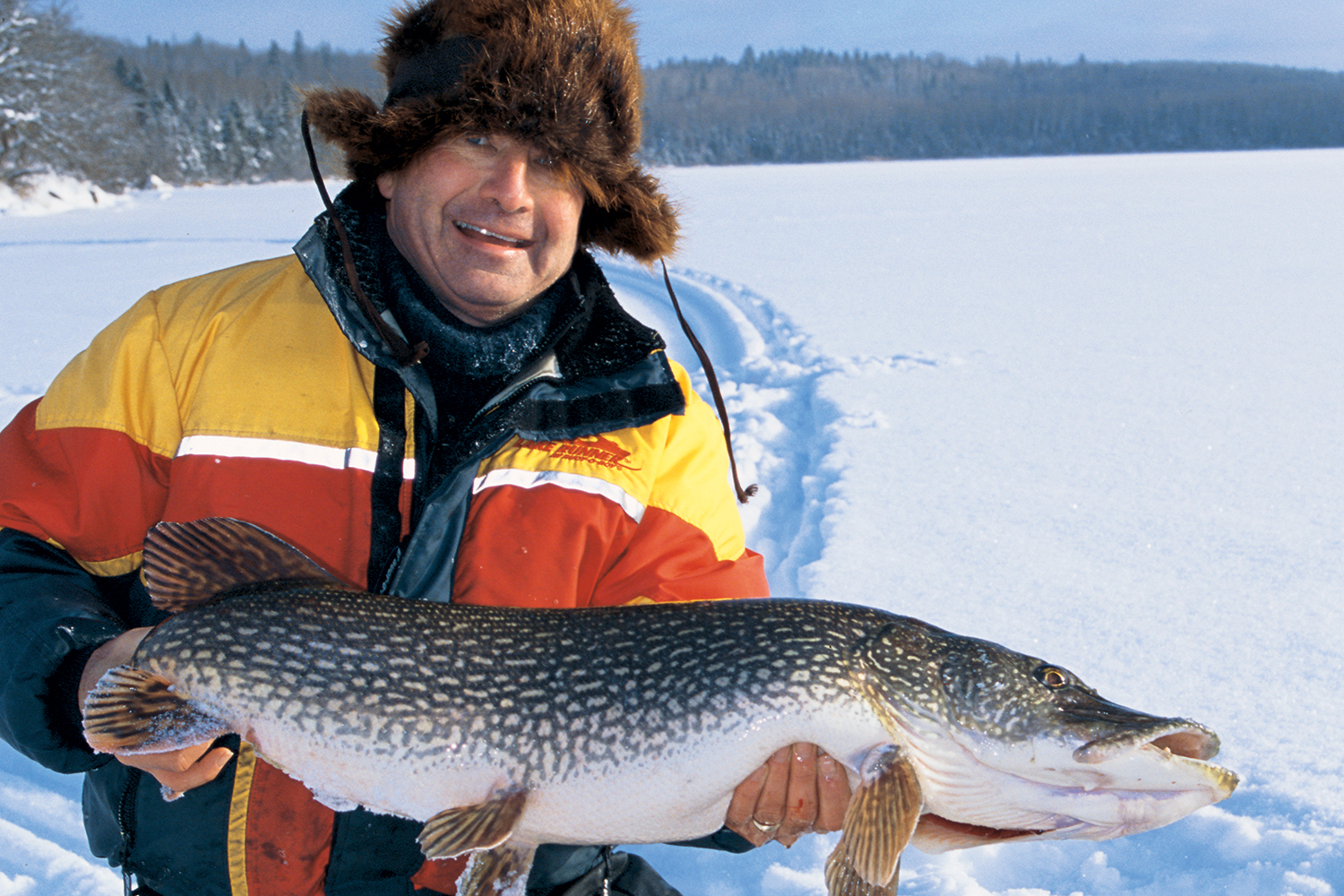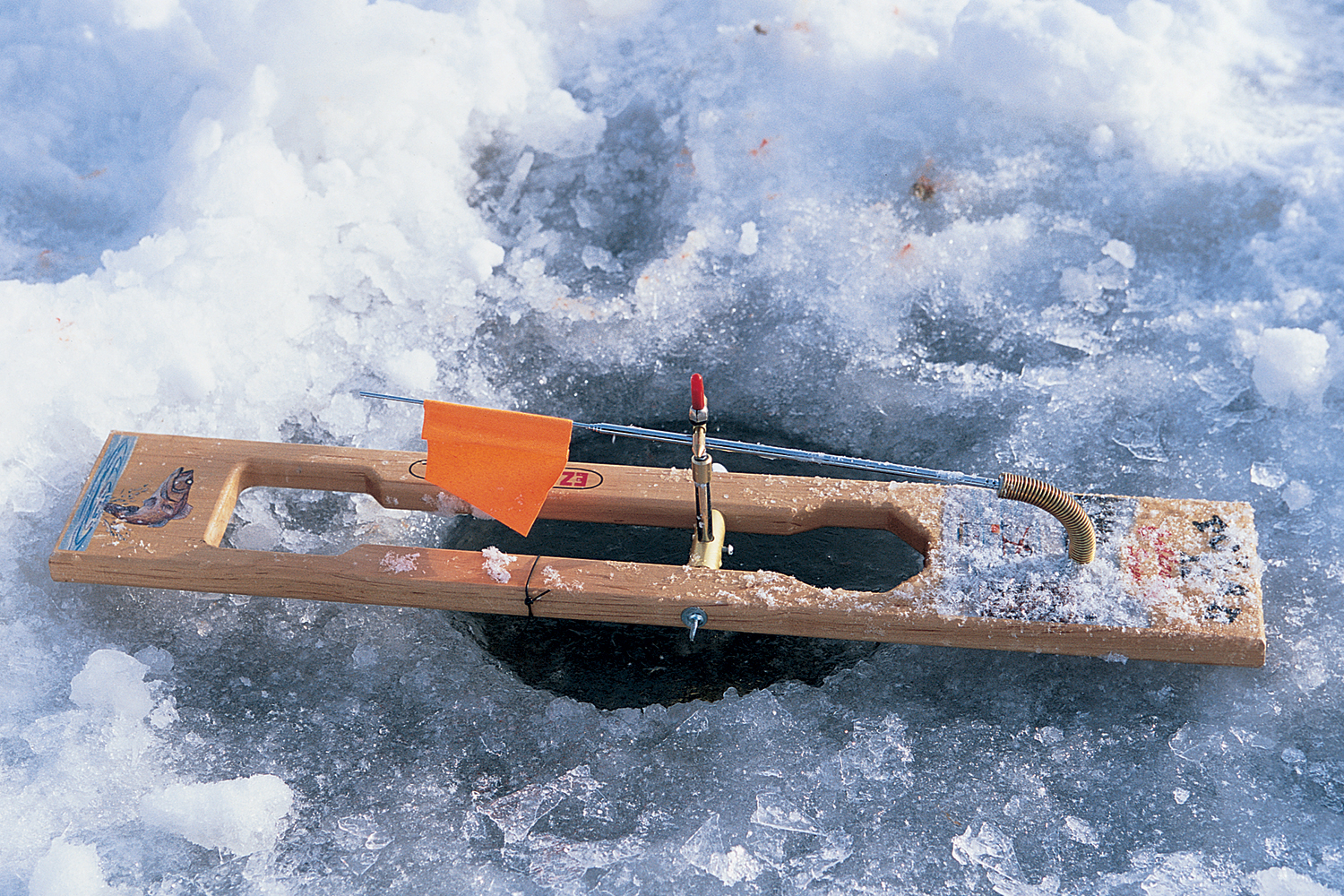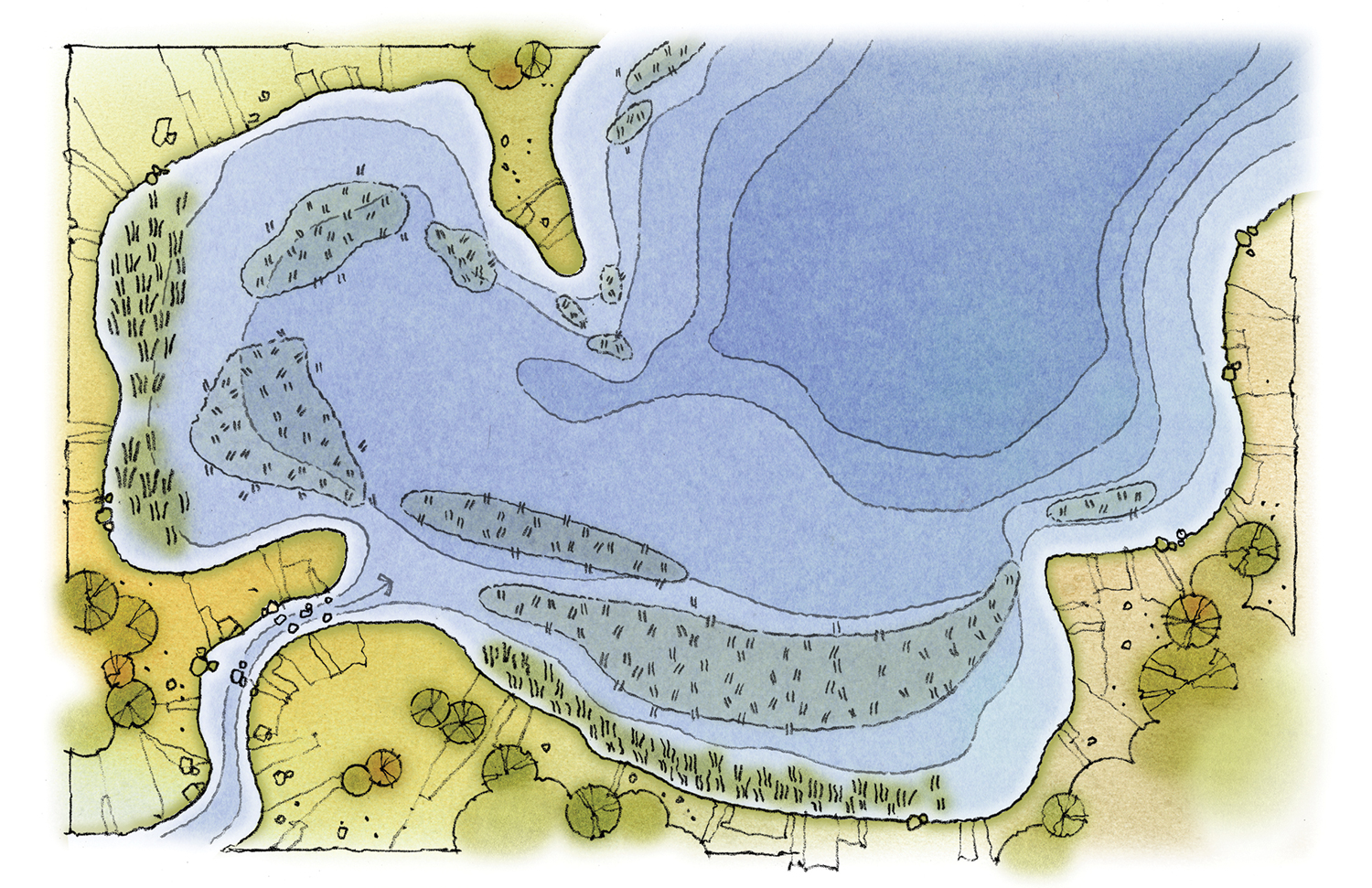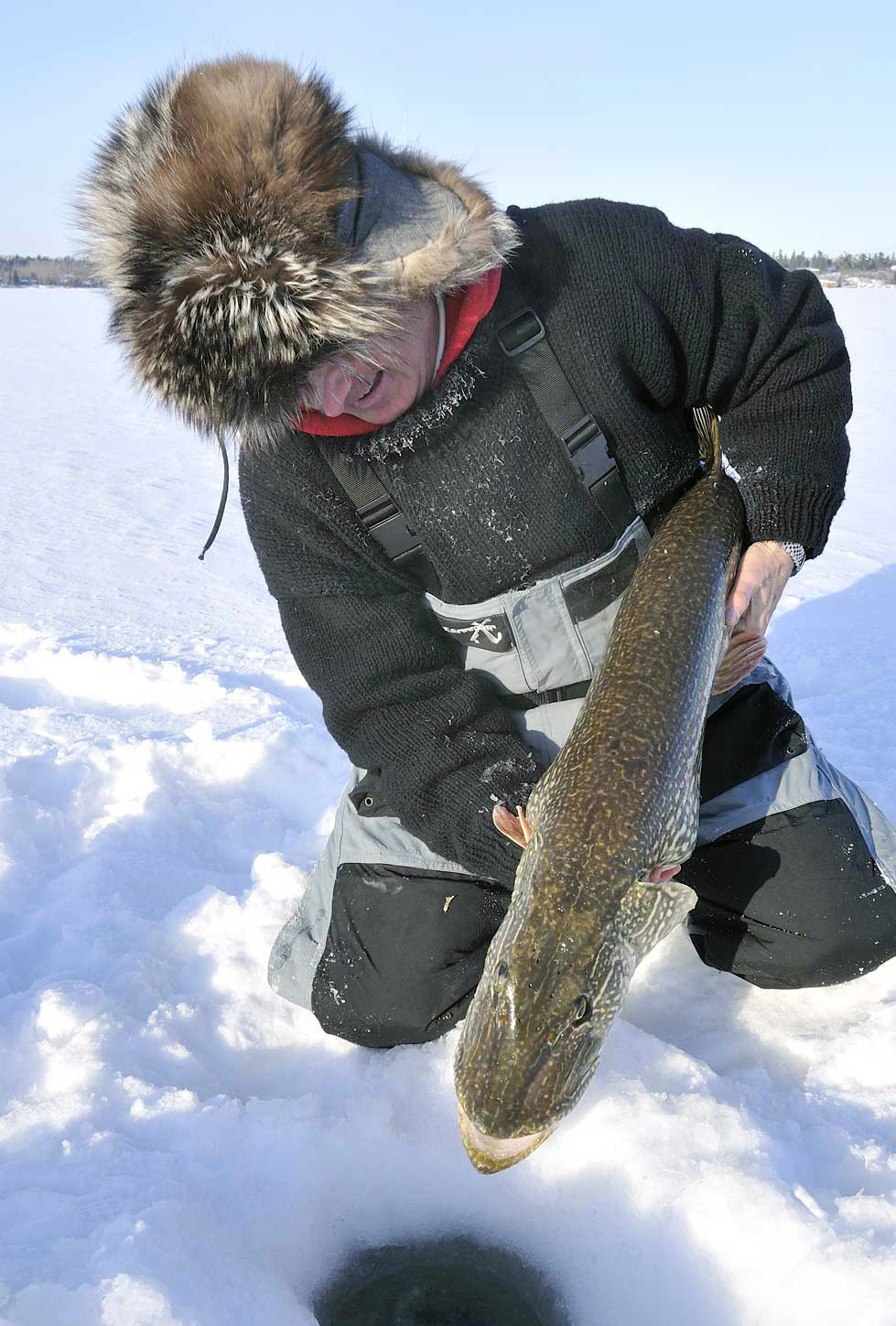
Most pike waters are complex worlds with considerable diversity, from the aquatic equivalent of lush rainforests to hostile deserts; yet, unlike our world—where landforms and features are relatively static—the environment in which most pike live is more dynamic. The layout can, and often does, change dramatically from one season or calendar period to the next. A portion of the lake that was pike paradise in summer can be a nightmare in winter.
“Pike in the winter are very poorly understood,” said Dr. John Casselman, former Senior Research Scientist with the Ontario Ministry of Natural Resources and a world-renowned pike specialist. “In fact, I’ve always said that we know less about what they do in the winter than any other time of the year. It is truly an unknown period of their life cycle. The more we learn about it, the more fascinating it becomes. What pike do in the winter is much more impressive than what they do in the summer.”
According to Casselman, our pike fishing success throughout the year, especially in the winter, is influenced strongly by three environmental factors: water temperature, the amount of dissolved oxygen it holds and the quantity of light streaming through it. These parameters affect the growth and survival of the fish, he said, and determine where we’re likely to find them. Also, in what mood.

Growth, Activity & Water Temperature
“Although the growth optimum for pike is 66°F to 70°F,” he explained, “they grow well in water temperatures ranging from 50°F to 73°F. That’s why we call them mesothermal or coolwater fish. They thrive in temperate environments where the water is highly transparent, where there is an abundance of vegetative cover, and where the development of the vegetation—open-water interface is high.”
Now, we’re not going to find many places in the winter where the water temperature is anywhere near optimal for pike—least of all, in prime pike country where most lakes, rivers, and reservoirs have at least a foot or two of ice and snow blanketing the surface. But knowing that water temperature affects a pike’s growth and activity is still important. While the fish increase in size much more slowly in the winter (only 3.9 percent of their maximum), unlike many other species they continue growing. That means they are stalking and ambushing prey, even though the icy water temperature may reduce their overall level of physical activity.
Casselman reports that pike can tolerate bone-numbing temperatures. He once studied the fish in some very shallow lakes on Manitoulin Island, northern Lake Huron, where they showed no apparent signs of stress even when subjected for extended periods of time to water temperatures as low as 32°F.
Light Levels
On the other hand, the amount of light entering the water column also has a demonstrable effect on pike activity levels. Casselman: “We see maximum growth in their natural environment during periods of the year when the amount of daylight is greatest. Long day-length periods stimulate growth, undoubtedly functioning through the endocrine system and possibly through thyroxin and growth hormone.”
Viewed another way, since pike feed by sight when days are long, as they typically are in the late spring and early summer, they consume more food more often, eating everything from suckers and perch to leeches and mayflies. Associated with extended dinner hours, not surprisingly, is a corresponding increase in swimming activity.
So, one would naturally assume that in the dead of winter, when the photoperiod is typically short, pike would feed very little. But that is not necessarily the case, as many pike anglers who have enjoyed excellent ice fishing are aware.
“The science community can’t fully explain some of the winter results,” Casselman said. “It is not known, for instance, why in some experiments where the day length was extremely short, and where it mimicked winter-illumination levels, the pike did not exhibit a marked decrease in their growth rate.”
Could it be that in winter, while the quantity of daylight may be much reduced, the quality of it, after having passed through a foot or more of ice and snow, may be close to ideal? It is an interesting and likely possibility.
“From angling studies conducted during the open-water period, we know that pike feed more actively on cloudy, overcast days than on bright, sunny days,” Casselman says. “On days when light intensity is high, they feed more actively during evening and to a lesser extent morning, twilight, and when light intensity is low.”
He said that typical light levels under the ice in winter may closely approximate prime light conditions during the open-water season. It’s also why winter pike anglers often enjoy good success on sunny winter days, when the same conditions during the open-water season would shut down the fish. As Casselman explained it, “The intensity of illumination in the laboratory that causes pike to be most active (300 to 700 lux) is more similar to the illumination just under the ice at midday in January (400 to 800 lux) than it is to summer midday intensities.”

Oxygen Concentration
Of all the environmental factors that affect a pike’s location, metabolism, and activity level during the winter months, Casselman said angler success is most directly related to the amount of oxygen in the water. If the level should fall below approximately 2 parts per million (or 22 percent air saturation), the fish cease feeding.
“Any decrease in oxygen concentration effects a decrease in growth rate,” he said. “The critical oxygen concentration is 0.84 parts per million. This lethal oxygen concentration is frequently encountered at low temperatures in association with winterkill. This mortality occurs in lakes where oxygen is depleted under the ice cover in late winter.”
Still, Casselman emphasized that pike are extremely tolerant of low winter-oxygen levels. In shallow, weedy lakes where oxygen is greatly reduced during the winter as a result of decomposition, the fish readily survive minimum oxygen concentrations as low as .3 parts per million (2 percent air saturation).”
While the pike may not die at these extremely low levels, their overall activity level and their feeding patterns are essentially nonexistent. Stressed for oxygen, the sluggish pike clearly have more urgent needs than finding—dinner.
He said that the ability of pike to withstand critically low winter-oxygen levels is likely a genetic characteristic inherited from the survivors of previous winterkill events. This fact explains why some pike may perish in one lake where winterkill is uncommon, yet survive in a shallower, weedier lake where the phenomenon is the rule, rather than the exception.
Forage
Casselman said these key environmental conditions, not an empty stomach, are what trigger pike to become active. In fact, in the laboratory, he said, when water temperature, light levels, and oxygen conditions become prime, pike activity is spontaneous and totally independent of foraging.
He also indicated that deteriorating environmental conditions can cause pike to become active, which in the process increases angling success. He discovered, for instance, that catch rates during January and February were often high because oxygen levels in shallow, weedy bays and coves were often depressed, the fish moving to areas of the lake where higher levels were present.
Pike have an astonishing ability to locate areas of a lake, river, or reservoir richer in oxygen in the winter, leaving behind much poorer-quality digs. According to Casselman, the fish are so attuned environmentally that they can follow a positive oxygen gradient, much like a hound on the trail of a fox.
Indeed, every supreme winter pike location I’ve ever found—without exception—has an oxygen-rich creek, stream or river flowing into it. An example of one of my favorite spots is a major bay adjacent to the basin of a large lake, where Editor-In-Chief Doug Stange and I set up last January, filming a segment for In-Fisherman television. The first pike that Doug hauled onto the ice and then carefully released was an imposing 22-pound fish. The second fish minutes later was a slightly smaller 20-pounder.

The 75-acre bay is chock full of lush cabbage in the open-water period. But the cabbage dies and will decompose over the winter, sucking precious oxygen from the water. They smell like mothballs, if you fish too close to the edge and snag one of last year’s stalks. The pike slide out of the shallow bay and set up on the first lead-in rocky point that defines the transition between the oxygen-rich, warm, deep-lake basin, and the oxygen-poor, cold and weedy flat. Pike may even ride out on, and relate to, the tongue of river water that runs through the center of the bay.
But not all the winter pike movements are horizontal like this. In shallow lakes where the big, toothy predators and their prey can’t escape to more oxygen-rich portions of the lake, the fish suspend directly under the ice where the last vestiges of oxygen remain. These vertical movements typically occur in February, as oxygen is depleted from bottom portions of the water column.
“The pike literally suspend on a 45-degree angle,” Casselman said, “with their mouths sucking in the last inch or less of water at the ice interface that still contains a trace of oxygen. I’ve watched as they’ve used their fins to fan the water around their heads to create a current of water. The current directs more water through their gills, but it also creates a dome under the ice. And the pike literally poke their noses through the surface into that pocket.”













